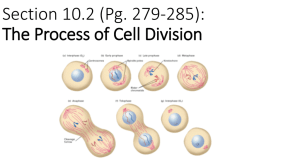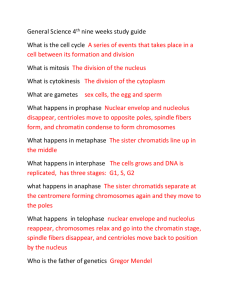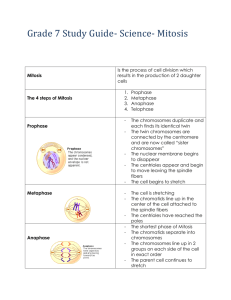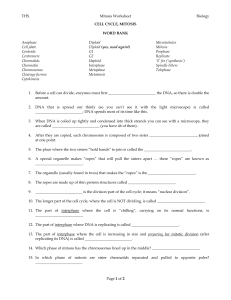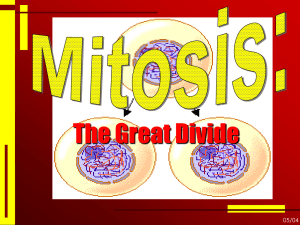Q1. (a) Mitosis is important in the life of an organism. Give two
advertisement
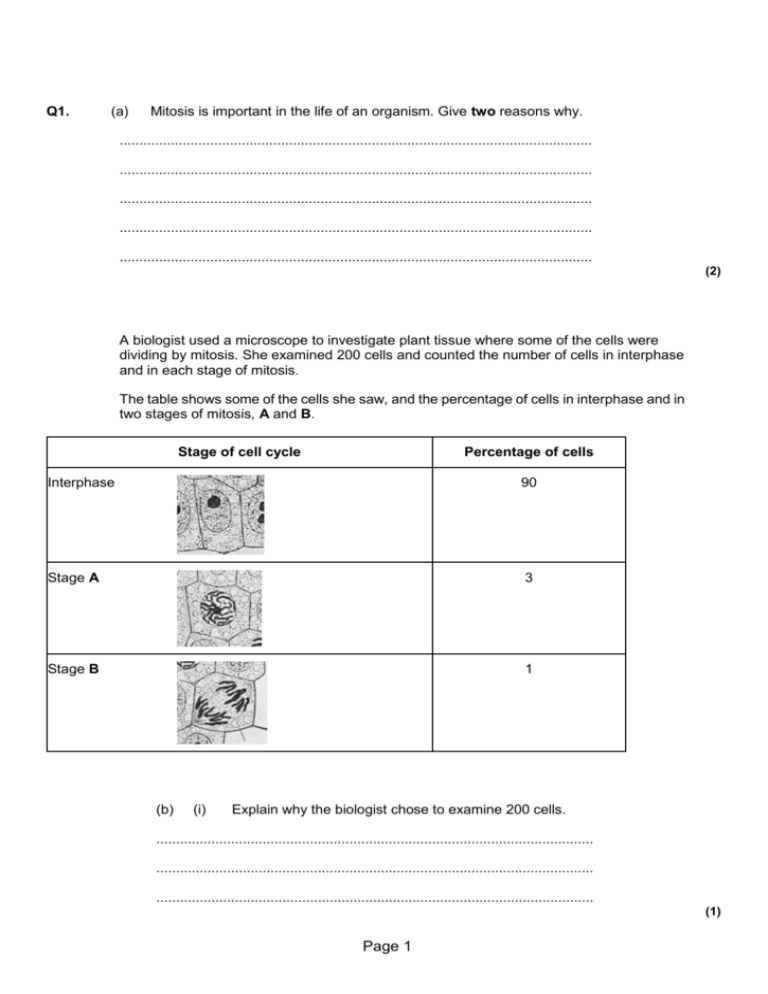
Q1. (a) Mitosis is important in the life of an organism. Give two reasons why. ........................................................................................................................ ........................................................................................................................ ........................................................................................................................ ........................................................................................................................ ........................................................................................................................ (2) A biologist used a microscope to investigate plant tissue where some of the cells were dividing by mitosis. She examined 200 cells and counted the number of cells in interphase and in each stage of mitosis. The table shows some of the cells she saw, and the percentage of cells in interphase and in two stages of mitosis, A and B. Stage of cell cycle Percentage of cells Interphase 90 Stage A 3 Stage B 1 (b) (i) Explain why the biologist chose to examine 200 cells. ............................................................................................................... ............................................................................................................... ............................................................................................................... (1) Page 1 (ii) Name Stage A and Stage B. Give the evidence from the photograph that you used to identify the stage. Name of Stage A ................................................................................... Evidence ............................................................................................... ............................................................................................................... Name of Stage B ................................................................................... Evidence ............................................................................................... ............................................................................................................... (4) (c) In this tissue one complete cell cycle took 20 hours. Using information from the table, calculate the mean time for these cells to complete mitosis. Show your working. Answer ...................................... (2) (Total 9 marks) Q2. (a) (i) The diagram shows a stage of mitosis in an animal cell. Name this stage. ............................................................................................................... (1) Page 2 (ii) Describe what happens during this stage that results in the production of two genetically identical cells. ............................................................................................................... ............................................................................................................... ............................................................................................................... ............................................................................................................... ............................................................................................................... (2) (b) A sample of epithelial tissue from the small intestine of an animal was analysed. Some of the cells had 8.4 units of DNA, others had only 4.2 units. (i) Use your knowledge of the cell cycle to explain why some cells had 8.4 units of DNA and others had only 4.2 units. ............................................................................................................... ............................................................................................................... ............................................................................................................... ............................................................................................................... ............................................................................................................... (2) (ii) How many units of DNA would you expect to be present in a gamete formed in this animal as a result of meiosis? (1) (Total 6 marks) Page 3 Q3. Describe what happens to chromosomes in meiosis. ...................................................................................................................... ...................................................................................................................... ...................................................................................................................... ...................................................................................................................... ...................................................................................................................... ...................................................................................................................... ...................................................................................................................... ...................................................................................................................... ...................................................................................................................... ...................................................................................................................... ...................................................................................................................... ...................................................................................................................... (6) Page 4 M1. (a) 1. Growth / increase in cell number; Ignore growth of cells 2. Replace cells / repair tissue / organs /body; Ignore repair cells Reject bacteria 3. Genetically identical cells; 3. ‘Produces 2 genetically identical cells’ does not reach MP1 as well as MP3 4. Asexual reproduction / cloning; 4. Allow example or description 2 max (b) (i) (Ensures) representative (sample); Accept find some cells in mitosis / not in interphase. Accept ‘more reliable’ only if linked to percentage (of cells).‘Improves reliability’ on its own does not gain this mark Neutral: Large sample 1 (ii) 1. A = metaphase; 2. Chromosome / chromatids lie on equator; 2. Reject homologous chromosomes Allow centre / middle 3. B = anaphase; 4. Chromatids / chromosomes separating / moving apart / moving to poles; 4. Reject homologous chromosomes 4 (c) 2 hours / 120 minutes; Allow 1 mark if working shows candidate understood that mitosis would take 10% 2 [9] M2. (a) (i) Anaphase 1 Page 5 (ii) 1. Sister / identical chromatids / identical chromosomes; 1. Reject: Homologous chromosomes separate. 1. Allow any reference to chromatids / chromosomes being identical e.g. same DNA 2. To (opposite) poles / ends / sides; 2 (b) (i) 1. 2. 8.4 / cells with twice DNA content = replicated DNA / late interphase / prophase / metaphase / anaphase; 1. Any reference to interphase must suggest towards end of interphase. 1. ‘Chromosomes replicate’ is not enough for DNA replicates. 4.2 = DNA not replicated / (early) interphase / telophase / cell just divided / finished mitosis; 2 (ii) 2.1; 1 [6] M3. 1. Chromosomes shorten/thicken/condense; 2. Chromosomes associate in homologous/(described) pairs / formation of bivalents / tetrads; 3. Crossing-over / chiasma formation; 4. Join to spindle (fibres) / moved by spindle;(*) 5. (At) equator/middle of cell;(*) 6. (join via) centromere / kinetochore;(*) 7. (Homologous) chromosomes move to opposite poles / chromosomes separate/move apart; (ALLOW ‘are pulled apart’) 8. (Pairs of) chromatids separated in 2nd division; (*) OR “ independent assortment” unqualified = 1 mark max 5 Page 6




